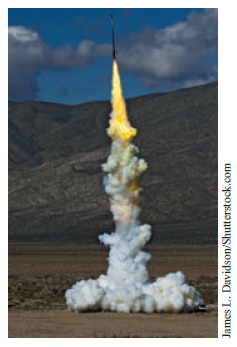In Problem 21, the mass m(t) is the sum of three different masses: m(t) = m p
Question:
(a) Show that the rate at which the total mass m(t) of the rocket changes is the same as the rate at which the mass mf (t) of the fuel changes.
(b) If the rocket consumes its fuel at a constant rate , find m(t). Then rewrite the differential equation in Problem 21 in terms of and the initial total mass m(0) = m0.
(c) Under the assumption in part (b), show that the burnout time tb > 0 of the rocket, or the time at which all the fuel is consumed, is where mf (0) is the initial mass of the fuel.
Data from problem 21
A small single-stage rocket is launched vertically as shown in the following figure. Once launched, the rocket consumes its fuel, and so its total mass m(t) varies with time t > 0. If it is assumed that the positive direction is upward, air resistance is proportional to the instantaneous velocity v of the rocket, and R is the upward thrust or force generated by the propulsion system, then construct a mathematical model for the velocity v(t) of the rocket.

Step by Step Answer:

A First Course in Differential Equations with Modeling Applications
ISBN: 978-1305965720
11th edition
Authors: Dennis G. Zill





